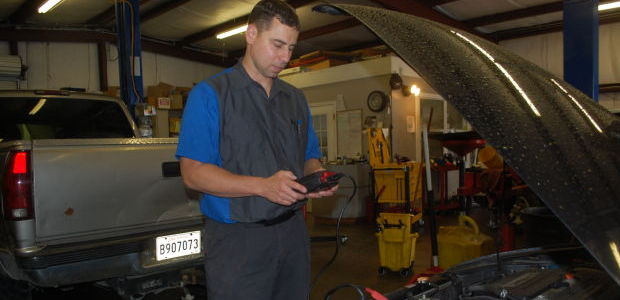Pickup trucks continue to outsell other vehicles
February 26, 2013
Houma repair shop prides itself on quality work
February 26, 2013Conflict over science – and a court decision that has infuriated the gasoline industry – have led to a request to be heard by the U.S. Supreme Court, over federal approval of a new gasoline blend with higher ethanol content.
The E-15 fuel formula, which contains up to 15 percent ethanol, an alternative additive made from corn and sometimes other grains, was approved by the US Environmental Protection Agency for use in most cars made in 2001 or later.
The choice will be up to consumers. E-15 is not required to be sold at gas pumps; permission has merely been given for it to be sold. Local service station technicians say they are following news about the blend, although a large block of automakers has already stated that E-15 use could void some warranties. And now a collection of forces opposed to E-15 use, including livestock interests affected by use of corn in fuel because of higher feed prices, wants the US Supreme Court to allow them to bring a court action against the EPA, since they were recently barred by a lower court from asserting their claims.
“It is difficult to precisely calculate how many vehicles E-15 could harm,” said Bob Greco, a spokesman for the American Petroleum Institute. “That depends on how widely it is used and other factors. But, given the kinds of vehicles tested, it is safe to say that millions could be impacted.”
Greco was referring to tests conducted by the Coordinating Research Council on behalf of the oil and auto industries.
“This additional E-15 testing, completed this month, has identified an elevated incidence of fuel pump failures, fuel system component swelling, and impairment of fuel measurement systems in some of the vehicles tested. E-15 could cause erratic and misleading fuel gauge readings or cause faulty check engine light illuminations,” Greco said. “It also could cause critical components to break and stop fuel flow to the engine. Failure of these components could result in breakdowns that leave consumers stranded on busy roads and highways.”
A 10 percent ethanol blend is currently available at pumps throughout the U.S., and the complaints from the oil and auto industries do not relate to that.
“Fuel system component problems did not develop in the CRC tests when either E10 or E0 was used,” Greco said, referring respectively to the 10 percent blend and also those gasoline blends with no ethanol.
The API and other groups had tried to fight EPA granting of waivers – limited permission for E-15 to be sold – by filing suit in federal court. A federal appeals court in Washington DC rejected that challenge, concluding that auto engine manufacturers, the petroleum industry and other petitioners – did not have standing to sue.
API and the other groups now want the US Supreme Court to review that decision. The Supreme Court only takes those cases it wishes to in all but a few instances, and the first step toward making that happen is filing of a petition with the high court’s clerk.
“We’ve filed this petition because the D.C. Circuit incorrectly concluded that none of the 17 petitioners had standing to challenge the E15 partial waivers – not the engine manufacturers whose products will run on this new fuel blend, not the petroleum industry who must undertake massive infrastructure changes to accommodate the blend and meet the renewable fuel mandate, and not the food producers who now face significantly greater competition in the commodities market for corn, the conventional feedstock for ethanol,” Greco said last week. “Had EPA stayed within its statutory authority and followed proper procedures, it would have waited until ongoing E15 testing on engines and fuel systems was completed before allowing the use of E15. Then it would have discovered that E15 is not safe for millions of vehicles now on the road.”
Stan Chauvin, service manager at Barker Mitsubishi in Houma, is among local mechanics and service technicians closely following the controversy.
“I have been told E-15 will affect rubber components in the system, I don’t think it gets the fuel economy that regular gas does,” Chauvin said. “I would tell you to try to avoid it.”
Some local gasoline outlets advertise their non-use of fuel containing ethanol altogether. One reason even the E-10 blend is frowned on here is the potential effect on boat motors.
“The ethanol starts to separate over a period of time,” said T.J. LeBlanc, parts manager at Dagate Marine on Barrow Street in Houma. “A boat might sit up for a month or two before you use it.”
That means the potential for lack of power, or inability of a boat motor to function at all in extreme cases, boaters say.
The American Automobile Association is among the voices warning consumers that E-15, once it makes its appearance at pumps, is not for everybody.
“It is clear that millions of Americans are unfamiliar with E15, which means there is a strong possibility that many motorists may improperly fill up using this gasoline and damage their vehicle,” said AAA President & CEO Robert Darbelnet. “Bringing E15 to the market without adequate safeguards does not responsibly meet the needs of consumers.”
Five manufacturers, BMW, Chrysler, Nissan, Toyota and Volkswagen, are on record saying their warranties will not cover fuel-related claims caused by the use of E-15, according to AAA. Seven additional automakers, Ford, Honda, Hyundai, Kia, Mazda, Mercedes-Benz and Volvo, have stated that the use of E15 does not comply with the fuel requirements specified in their owner’s manuals and may void warranty coverage, the AAA further states.
The only vehicles currently approved by automakers to use E15 are flex-fuel models, 2001 model-year and newer Porsches, 2012 model-year and newer GM vehicles and 2013 model-year Ford vehicles,” Darbelnet said in a AAA statement. “These approvals extend only to cars, light-duty trucks and medium-duty passenger vehicles, SUVs. The use of E15 is expressly prohibited in heavy-duty vehicles, boats, motorcycles, power equipment, lawn mowers and off-road vehicles.”
Darbelnet has called for suspension of E-15 sales until motorists can learn more.









